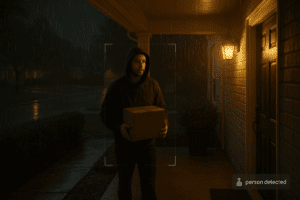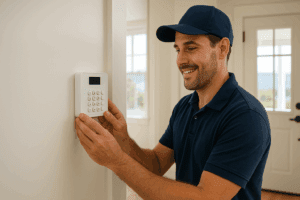Cunningham Security offers reliable, professional monitoring with the communication path that fits your property: landline, cellular, IP, or AES. Our promise is simple: local, white-glove service—backed by national-grade monitoring resources. We pick up fast, keep things clear, and handle the details so you can get on with your day.
Why Cunningham for Monitoring?
Local service, national resources
You’ll work with a local team that knows your area—paired with a world-class monitoring partner. It’s the best of both: white-glove service and national-grade reliability.
- Fast, human support from our local technicians
- Design, programming, and clean handoffs (no runaround)
- 24-hour on-call coverage when you need us most
Credentials that matter
We partner with Affiliated Monitoring, a UL Listed, TMA Five Diamond, and FDNY Approved monitoring center—so your signals are handled by rigorously trained pros in redundant facilities.
Learn more: Affiliated Monitoring Certifications
Built around your system
We support multiple communication paths—POTS, cellular, IP, and AES—and we’ll recommend the right one (or dual-path) based on your location, building, and uptime needs.
- Keep your existing gear where it makes sense
- Upgrade only what improves reliability or response
- Video verification and app control available
Local Service Areas
- Alarm.com Monitoring in Maine
- Alarm.com Monitoring in New Hampshire
- Alarm.com Monitoring in Massachusetts
Plans & Pricing
Residential Monitoring
- Landline: from $30/month
- Cellular: from $40/month
- Also available: IP & AES monitoring
12-month agreement, then month-to-month. Final pricing depends on communicator type and system configuration.
Small Business & Commercial
- Cellular or Dual-Path recommended for uptime
- Open/close reports, user code management
- Video verification & proactive video monitoring
Request a quote for multi-site or higher-risk locations.
How Professional Monitoring Works (in 60 seconds)
When an alarm triggers, your system sends a signal over your chosen path (landline, cellular, IP, or AES) to our monitoring center. A trained operator confirms the event, uses Enhanced Call Verification (ECV) to cut false dispatches, and notifies the right responders. If you enable video verification, operators can review clips tied to the alarm to speed decisions and response.
| Path | Best for | Pros | Considerations |
|---|---|---|---|
| Landline (POTS) | Basic, budget-friendly setups | Lowest monthly cost; uses existing phone line | Susceptible to line cuts; aging infrastructure in some areas |
| Cellular | Most homes & small businesses | Reliable, no phone line required; widely available | Requires solid carrier coverage; communicator hardware |
| IP | Properties with robust internet | Fast signaling; leverages existing network | Dependent on power/internet; add battery/backup for resilience |
| AES Radio | High-reliability or code-driven sites | Independent radio mesh; resilient where available | Availability varies by region; specialized hardware |
| Dual-Path | Uptime-critical applications | Redundancy: two paths (e.g., Cell + IP) | Slightly higher monthly; best practices for business |
Options That Improve Response & Usability
Video Verification
When an alarm trips, a short video clip from the nearest camera is sent alongside the signal so an operator can see what triggered it—person, pet, delivery, wind, or something truly urgent. That context helps reduce false dispatches, gets you faster, more confident decisions, and can improve priority with responding agencies that accept verified events.
We’ll map cameras to the right sensors (door, motion, glassbreak) so the clip that matters arrives with the alarm. Think entry doors, driveways, loading bays, and interior “choke points” where someone must pass. You can choose which events create clips, how long those clips run, and who else (you, managers, neighbors) should receive a copy.
Best uses:
Front door/doorbell, garage and driveway approaches, back or side entries
Interior hallways that connect major rooms or safes/cash rooms
Areas with recurring nuisance alarms where visual confirmation would prevent a dispatch
What you’ll notice: fewer “cry wolf” moments, clearer reports, and faster callbacks when something real happens. If you prefer, we can also include a simple escalation rule—e.g., “Only dispatch if a person is present.”
Video Monitoring & Virtual Guard
Video verification is reactive (the camera confirms an alarm). Video monitoring is proactive. Live agents watch for specific behaviors—loitering after hours, someone entering a fenced area, a vehicle lingering in a lot—and step in with two-way talk-down, sirens, or lights before a crime or incident escalates.
We’ll pair smart analytics (people/vehicle detection, line crossing, left-behind objects) with schedules that mirror your business hours. When the system flags activity, a trained agent reviews the live feed in seconds, speaks directly through on-site speakers (“This area is closed—security is responding”), and follows your escalation script. For higher-risk sites, we can add virtual tours (guard “rounds” on a schedule) and focused watch lists for recurring issues.
Perfect for: yards and laydown areas, dumpsters and back alleys, parking lots and garages, equipment pads, vacant properties, and any facility with predictable quiet hours.
Learn more: Ask us how video monitoring pairs with your alarm plan to reduce guard costs and improve after-hours safety. We’ll recommend the right mix of talk-down speakers, floodlights, and camera coverage for your site.
Custom System Design
No two properties are the same. We’ll walk the space (or review plans), look at natural choke points and lighting, and design a system that fits how you live or work. That means placing sensors and cameras where they’ll actually catch useful events, choosing the right communication path (landline, cellular, IP, AES, or dual-path), and setting up alerts that are helpful—not noisy.
For homes, we’ll consider pets, overnight routines, and frequently used doors so arming is painless. For businesses, we’ll align zones with operations—receiving doors, cash rooms, office suites—then layer in schedules, user codes, open/close reports, and optional video verification. Where it saves money and time, we’ll reuse wiring and compatible devices; where reliability or code demands it, we’ll recommend upgrades. The end result: a system that’s quiet when it should be, loud when it must be, and easy to live with every day.
Security Audit
If you already have a system, we’ll put fresh eyes on it. Our audit covers coverage (what areas are actually protected), camera views and night performance, sensor age and placement, communication path resilience, battery backup, and user hygiene (too many old codes, missing contacts, etc.). We’ll also check for single points of failure—one dead modem, one old battery, one unreachable keypad—that tend to fail at the worst time.
You’ll get a prioritized plan:
Must-fix (safety/code issues or obvious reliability risks)
Should-fix (gaps and dated gear that hurt day-to-day performance)
Nice-to-have (quality-of-life or future-proofing upgrades)
We’ll show you what to keep, what to retire, and where a small change—like switching to dual-path monitoring or moving a single camera—delivers outsized improvement.
Where We Monitor
We serve customers across Maine and the North Shore of Massachusetts, with local teams in Falmouth and Wiscasset, ME, and Topsfield, MA (formerly SOS Home Systems). If you prefer in-person support, we’re nearby; if you want fast remote help, our techs and 24/7 monitoring center have you covered.
Alarm Monitoring FAQs
How much does monitoring cost?
Monitoring starts at $30/month for landline and $40/month for cellular. We also support IP and AES paths. Your quote depends on the communicator type, property needs, and any add-ons like video verification.
What contract terms do you require?
A 12-month agreement, then it renews on a month-to-month basis. No multi-year lock-in required.
Can you monitor a system you didn’t install?
Often, yes. Many systems can be monitored after a communicator swap or programming update. If you’re switching from another provider, start here: Alarm System Takeover.
Who handles the actual alarm signals?
Our partner is Affiliated Monitoring—a UL Listed, TMA Five Diamond, and FDNY Approved monitoring center with redundant facilities and trained operators. You get national-grade reliability, with our local team handling design, service, and support.
What’s Enhanced Call Verification (ECV)?
ECV means operators quickly call through your contact list to confirm an alarm before dispatch—reducing false alarms and fines while still moving fast when it’s real.
Do you offer video verification?
Yes. We can link cameras to specific alarm events. When a sensor trips, a short clip is sent to the monitoring center so operators can assess what’s happening and notify responders.
Do you provide insurance certificates?
Yes. We can provide a monitoring certificate for your insurer upon activation.
Ready to Get Started?
Tell us about your system and goals. We’ll recommend the right path (landline, cellular, IP, AES), outline costs, and make switching easy if you’re coming from another provider.
Pricing shown is starting pricing; final costs depend on equipment, communication path, and any add-ons. Local permit requirements may apply.

